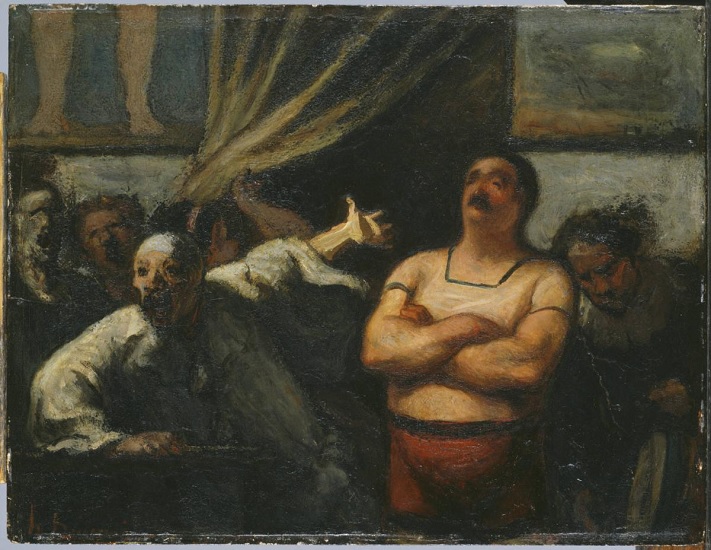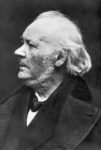
Honoré Daumier
French, 1808–1879
The Strong Man, 1865 ca.
oil on wood panel
10 5/8 x 13 7/8 in.
The Phillips Collection, Acquired 1928

Daumier c.1875
“I must ask you whether there are cheap prints by Daumier for sale, and if so, which. I’ve always believed him to be highly gifted, but it’s only recently that I begin to suspect that he’s of even greater importance than I thought. If you know anything special about him, or know of important things among his drawings, do write about them if you will. In the past I saw caricatures by him, and perhaps because of them got an idea about him that wasn’t the right one. His figures always struck me the most, but I believe that I know only a very small part of his work and that, for instance, the caricatures are definitely not his most typical or main work.
I remember that we talked about this last year on the road to Princenhage, and you said then that you thought Daumier more beautiful than Gavarni and I took Gavarni’s side and spoke to you of the book about Gavarni that I had read and that you now have. But I must say that, although I still like Gavarni just as much, I begin to suspect that I know only a very small part of Daumier’s work AND THAT IN THE PART OF HIS WORK I DO NOT KNOW are the very things that would interest me most of all (however much I already appreciate what I know by him). And I also dimly remember — but I may be wrong — you telling me about large drawings, types or portraits from the common people, and I’m curious about them. If there were more things by him as beautiful as a print by him that I recently found, ‘The 5 ages of a drinker’, or as that figure of an old man under a chestnut tree I told you about before, well, then he was perhaps the master of them all.” – Letter to Theo, 29 October 1882
COMMENTS
“The Strong Man” is related to two crayon sketches of the barker and a charcoal study of the strongman. In the present work these figures join others to form a complex composition. The subject is a parade, or sideshow, in which clowns, musicians, barkers, and strongmen perform before a theater or tent to solicit customers for the spectacle within. These shows were popular during the eighteenth century in connection with “Commedia dell’ Arte” performances at fairs. By the time Daumier painted most of his parade pictures, in the 1860s, they were no longer a common feature of the Paris scene, although they could still be found in the temporary fairgrounds set up during festivals.
Sharp light illumines the strongman, whose relatively warm colors set him in striking relief to the subdued gray and blue tones of the rest of the image. His muscular, barrel-chested body contrasts with the backdrop, which consists of flat, rectilinear sections; a pair of legs in the upper left appears to be part of a poster advertising one of the acts. A clown-like barker exhorts the crowd to notice the proud “Hercules.” His stentorian claims are emphasized by his bold gesture and punctuated by his dramatically lit hand, in the center of the composition. The spectral faces of the barker and the open-mouthed figures behind him are grotesque, giving the scene an intensely expressionistic quality.
While Daumier’s earlier depictions of parades often lampoon their persistent, frenzied hawking, his works from the 1860s exaggerate to the point that they assume a demonic, nightmarish aspect. It has been suggested that because he was forbidden by censorship laws to caricature French politicians, Daumier may have expressed his dislike of Louis Napoleon and his propaganda machine in more oblique ways. There is reason to believe that the Phillips picture may thus constitute a work of social commentary in which the metaphor of the sideshow is used to condemn the “propaganda activities of the Age of the Empire which deftly assessed and manipulated the new political weapon of the era—public opinion.”
https://www.phillipscollection.org/collection/strong-man
Vincent van Gogh produced his first drawings while staying at his parents' home in Etten, The Netherlands, schooled chiefly by books on anatomy, perspective and artistic technique. The artist restricted his first drawings to a black and white palette, believing mastery of this discipline to be essential before attempting works in color.
His first drawings of people depict various peasants in static poses, some in profile, while his premier landscapes are largely studies in perspective. In his early pen and watercolor drawings, Vincent incorporated shadow and light rather than color to create dimension. Drawing upon the weighty influences of masters such as Millet, Rembrandt and Daumier, the artist's focus on the human figure was critical to his artistic development.
Midway through 1881, Vincent van Gogh engaged in a brief period of study with Anton Mauve, a master in The Hague School of art. Mauve not only covered the basics but also introduced his pupil to watercolors and oils, thus broadening the artist's scope of expression. Vincent's “Still Life With Cabbage and Clogs”, one of his first paintings, makes use of the somber earth tones that characterize his early works in the Dutch style. It also features a rich splash of color, a harbinger of the brilliant Van Gogh painting style to come.
During a stay in the northern village of Nuenen in late 1883 through 1885, the painter focused on agrarian scenes of peasants working the soil and weavers plying their craft. In 1885, the artist produced The Potato Eaters, a work many consider to be his first masterpiece. In this depiction of a farm family seated around their humble table, Vincent van Gogh invokes the influence of Rembrandt by virtue of the shadowy setting that is nevertheless filled with personality and life. A heaping plate of potatoes illustrates the simple wealth of those who earn their living on the land. The companionable atmosphere, lit by the warm glow of a single lamp, inspires in the viewer a yearning to take part in this lowly yet companionable scene. ...
https://www.vincentvangogh.org/
SBMA CURATORIAL LABELS
Daumier was one of the many French printmakers whose work Van Gogh knew well and collected, and whom he admired for his “terrifying truthfulness” in his depiction of everyday life. Daumier earned his living as a caricaturist for such satirical magazines as Le Charivari, for which he created some 3,900 lithographs: typically biting caricatures that lampooned politicians, as well as all manner of social classes, from low to high.
Daumier’s paintings, however, remained relatively under-recognized for their daring modernity until after his death. Largely self-taught, Daumier dwelled frequently on the urban poor, using an anti-academic, gestural brushwork that, like Vincent’s, seems to anticipate the progressive art of the next generation. The dark tone of this painting of a parade of sideshow characters, hawking their attractions, has been interpreted as a parodic condemnation of the propaganda wielded under successive monarchs to manipulate public sentiment.
- Through Vincent's Eyes, 2022
